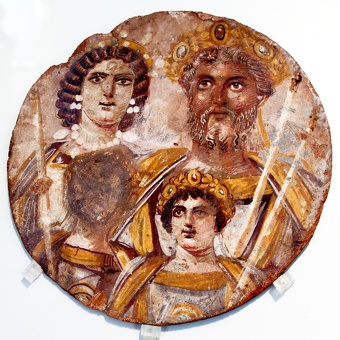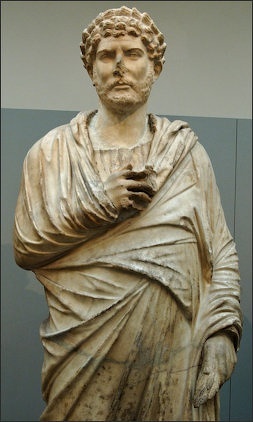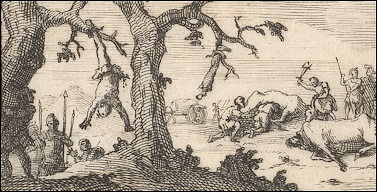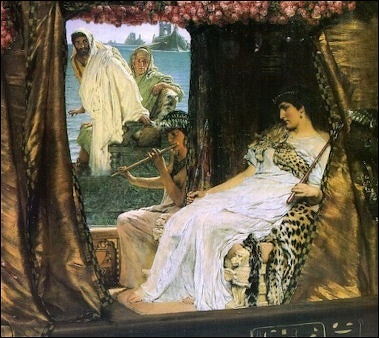Home | Category: Culture, Literature and Sports / Government and Justice
PROPAGANDA IN ANCIENT ROME

chained Germanic barbarian
Propaganda is regarded as a relatively modern invention, but over 2,000 years ago Romans were already raising 'spin' to a high art. Dr Neil Faulkner wrote for the BBC: “All empire-builders have to justify what they do - to themselves, to their own people, and to those they dominate. The Romans developed a sophisticated world-view which they projected successfully through literature, inscriptions, architecture, art, and elaborate public ceremonial. [Source: Dr Neil Faulkner, BBC, February 17, 2011. Dr Faulkner is an honorary lecturer at the Institute of Archaeology, University College London. |::|]
“Some elements of this world-view evolved during the existence of the empire, most notably with the adoption of Christianity in the early fourth century AD. Other themes remained constant. Perhaps the most important of the latter was the idea that Rome represented peace, good government, and the rule of law. The societies with which Rome was in conflict were caricatured as barbaric, lawless and dangerous. |::|
“Julius Caesar, in his famous account of the Gallic Wars of the 50s B.C., provided readers at home with a blood-curdling description of the Germanic tribes he encountered in battle: 'The various tribes regard it as their greatest glory to lay waste as much as possible of the land around them and to keep it uninhabited. They hold it a proof of a people's valour to drive their neighbours from their homes, so that no-one dare settle near them. No discredit attaches to plundering raids outside tribal frontiers. The Germans say that they serve to keep young men in training and prevent them from getting lazy.' |::|
According to Archaeology magazine: The Roman builders of the Antonine Wall used vibrantly painted sculptures as a propaganda tool to convey Rome’s superiority over native Scottish tribes. When the wall was built in the mid-2nd century A.D., sculpted blocks depicting Rome’s military exploits were periodically embedded into it at strategic locations. X-ray and laser technology has now shown for the first time that they were originally finished with red and yellow paint, which would have enhanced their visual impact.
See Separate Articles: COMMUNICATIONS IN ANCIENT ROME: POSTAL SERVICE, SOCIAL MEDIA, SIGNALS europe.factsanddetails.com ; GRAFFITI IN THE ROMAN ERA europe.factsanddetails.com
RECOMMENDED BOOKS:
“Imperial Ideology and Provincial Loyalty in the Roman Empire” by Clifford Ando (2013) Amazon.com;
“Augustus, First Roman Emperor: Power, Propaganda and the Politics of Survival”
by Matthew D. H. Clark (2010)– Amazon.com;
“Power of Images in the Age of Augustus” by Paul Zanker and Alan Shapiro (1988) Amazon.com
“Augustan Culture” by Karl Galinsky (1996) Amazon.com
“Augustan Rome” by A Wallace-Hadrill, (Classical World, 1998) Amazon.com;
“The Roman Games: A Sourcebook (Blackwell) by Alison Futrell Amazon.com;
“The Oxford Handbook Sport and Spectacle in the Ancient World” by Alison Futrell, Thomas F. Scanlon (2021) Amazon.com;
“Spectacle in the Roman World” by Hazel Dodge (2011) Amazon.com;
“The Day Commodus Killed a Rhino: Understanding the Roman Games” (Witness to Ancient History) by Jerry Toner (2015) Amazon.com;
“Game of Death in Ancient Rome: Arena Sport and Political Suicide” by Paul Plass (1995) Amazon.com;
“Rituals and Power: The Roman Imperial Cult in Asia Minor” (Reprint Edition)
by S. R. F. Price (1954-2011) Amazon.com;
“Emperor Worship and Roman Religion” (Oxford Classical Monographs)
by Ittai Gradel (2002) Amazon.com;
“The Roman Imperial Cult: Emperor Anastasius I: A Practical Manual for the Worship of the Divine Emperor” by Marcus Julianus Amazon.com;
“Roman Emperor Worship” by Louis Matthews Sweet (1919) Amazon.com;
“Constructing Autocracy: Aristocrats and Emperors in Julio-Claudian Rome”
by Matthew B. Roller (2016) Amazon.com;
“The Ruler's House: Contesting Power and Privacy in Julio-Claudian Rome”
by Harriet Fertik (2019) Amazon.com;
“The Government of the Roman Empire: A Sourcebook” (Routledge) by Barbara Levick Amazon.com;
“Politics and Government in Ancient Rome” (Primary Sources of Ancient Civilizations). by Daniel C. Gedacht (2003) Amazon.com;
“Politics in the Roman Republic” by Henrik Mouritsen Amazon.com;
“Caesar: Politician and Statesman” by Mattias Gelzer, Peter Needham (1968) Amazon.com;
“Temples, Religion and Politics in the Roman Republic” by Eric M. Orlin (1996) Amazon.com;
“Controlling Laughter: Political Humor in the Late Roman Republic” by Anthony Corbeill (2016) Amazon.com;
Damnatio Memoriae
Damnatio memoriae is a process in which the memory of a person (usually an emperor but sometimes also other important people) was erased through the defacing of monuments and coins. Michael Van Duisen wrote for Listverse: “A practice common with nearly every ancient culture, and even some today, damnatio memoriae was the ritualistic and symbolic removal of a person from history. Seen as the worst punishment imaginable, worse than execution, the damned’s name was scratched from inscriptions, frescos with his face were painted over, and any statue was defaced, as if it was really him. It was normally reserved for the worst emperors in Roman history; Caligula escaped this punishment by having powerful friends, even after death. [Source: Michael Van Duisen, Listverse, February 13, 2014]

199 AD tondo of the Severan family; the face of one of Severus' sons has been erased perhaps as a result of the damnatio memoriae ordered by his brother
“Only a handful of emperors are known to have been officially given this punishment, including Maximian, whose friend and co-emperor Diocletian is said to have been so stricken with grief that he died shortly after hearing the news. Obviously, it didn’t work as well in practice as it did in theory; we still know about everyone who was the subject of damnatio memoriae. Some scholars feel it may have served a cathartic purpose for the public, enabling them to vent their frustration over the failures of their leaders.”
Emma Southon wrote in National Geographic History: Romans who lived exemplary lives could be pronounced gods after death, but villains faced the postmortem punishment of damnatio memoriae, of having one’s name erased from history. If the government declared it, one’s name would be struck from public and private records, property seized, and portraits defaced. Caligula and Nero were two early emperors who were damned. Roman women could also be condemned; most were sentenced along with their husbands. Only a few, such as Messalina and Julia the Elder (daughter of Augustus Caesar), received their own condemnation outright. The practice continued into later eras. In the early 200s, Emperor Caracalla condemned his brother Geta after murdering him. Portraits of Geta, even as a boy like this one, were defaced, and it became a crime to say his name. [Source: Emma Southon, National Geographic History, March 3, 2023]
Candida Moss wrote in the Daily Beast: Nero was the victim of a damnatio memoriae. The problem with this process, as Princeton classicist Harriet Flower has written, is that it just doesn’t work. Excisions leave a mark that only draws more attention to what was once there. Erasure was especially ineffective in the case of Nero: The man who could not be controlled in life could not be controlled in death either.[Source: Candida Moss, Daily Beast, July 24, 2022]
Roman Mission: Civilizing the Uncivilized
Dr Neil Faulkner wrote for the BBC: “Barbaricum was not only a place of perpetual strife. There was also grinding poverty and cultural backwardness. Describing the Caledonian tribes of ancient Scotland in the early third century AD, Dio Cassius wrote: 'They inhabit wild, waterless mountains and lonely, swampy plains, without walls, cities, or cultivated land. They live by pasturing flocks, hunting, and off certain fruits. They live in tents, unclothed and unshod, sharing their women and bringing up all their children together.' [Source: Dr Neil Faulkner, BBC, February 17, 2011 |::|]
Clearly, the implication seems to be, such people could not but benefit from Roman rule. But even those already civilised - those, indeed, whom many Romans recognised as more civilised than themselves - stood to gain. |There is a famous passage in Virgil's Aeneid, written in the reign of the first emperor, Augustus (30 B.C. - 14 AD), where the achievements of the Greeks are acknowledged, but their need of Roman government asserted. |::|
“'Others [that is, Greeks] shall hammer forth more delicately a breathing likeness out of bronze, coax living faces from the marble, plead causes with more skill, plot with their gauge the movements in the sky and tell the rising of the constellations. |'But you, Roman, must remember that you have to guide the nations by your authority, for this is to be your skill, to graft tradition onto peace, to spare those who submit, but to crush those who resist.'” |::|
Hadrian: Propaganda. Commonwealth and Consolidation

Hadrian dressed like a Greek
Dr Neil Faulkner wrote for the BBC: “At first, the principal audience for Roman imperial propaganda had been only a minority of the empire's population - mainly soldiers, the inhabitants of Rome and Italy, and Roman citizens living in colonies and provincial towns. |At this time, the empire was still expanding, and the role of the emperor as generalissimo was emphasised. But from the time of the emperor Hadrian (117 - 138 AD), aggressive wars all but ceased, and the empire was consolidated on existing frontiers. “As well as stressing the role of the emperor as civil ruler, Roman propagandists henceforward developed a more rounded and inclusive view of what it meant to be part of the empire. [Source: Dr Neil Faulkner, BBC, February 17, 2011 |::|]
“Greek culture was embraced more wholeheartedly than before, and the resultant blending of themes and motifs produced a distinctive Graeco-Roman or 'classical' culture during the second and third centuries AD. Hadrian and his successors actively promoted the idea that the empire, while embracing a diversity of peoples and religions, was united by an overarching set of values and tastes - and therefore by loyalty to the imperial state which safeguarded these. This conception of empire as a commonwealth of the civilised - in contradistinction to both barbarians beyond and subversives within - was monumentalised in stone on the frontiers and in the cities. |::|
“Hadrian's Wall was not a defensive structure. The Roman army at the time did not fight behind fixed defences. 'He set out for Britain', Hadrian's biographer tells us, 'and there he put right many abuses and was the first to build a wall 80 miles long to separate the barbarians and the Romans.' Equally, if it was intended as a line of customs and police posts - a controlled border - it was an extraordinarily elaborate and expensive one. So what was is for? |::|
“There seems little doubt that the wall, like other great Roman frontier monuments was as much a propaganda statement as a functional facility. It was a symbolic statement of Roman grandeur and technique at the empire's furthest limit, and a marking out of the point in the landscape where civilisation stopped and the barbarian wilderness began. |::|
“Hadrian's travels took him across the empire. Everywhere - in Rome, France, Spain, Africa, Greece, Turkey, Egypt - he raised great monuments. Instead of battles, he gave the empire bath-houses. Instead of trophies, temples and theatres. Most of the ruins we see today visiting the great classical cities of the Mediterranean are of public buildings erected in the second century golden age of imperial civilisation inaugurated by Hadrian. Each one made a set of statements. In its functionality, it helped define the Roman lifestyle and what it meant to be 'civilised'. In its towering size and richness, it spoke of the wealth and success of empire. |Through images on fresco, mosaic and sculpted panel, it promoted a cultural identity and shared values. And in the very fact of its existence, it redounded to the credit of the regime whose guiding hand had made it possible.” |::|
Setting a Example, Bloody, Pagan Roman Style

Roman military punishment of dismemberment
Dr Neil Faulkner wrote for the BBC: “But beneath the veneer of gentility, there was a chilling note of warning. Myths depicted men ripped apart for defying the gods or challenging those who - like the emperors - enjoyed divine protection. Legends from Rome's past told of enemies vanquished, lands laid waste and thousands sold to slavery. And in the amphitheatre, dramas of life-and-death were acted out which symbolised the gulf between friend and enemy, citizen and barbarian, freeborn and slave, loyalist and dissident. Gladiators fought to the death dressed to mimic historic enemies like Samnites, Gauls and Britons. Christians were eaten alive by half-starved beasts. Rebels and outlaws were burnt at the stake. The arena offered a pageant of 'the war on terror' Roman-style. [Source: Dr Neil Faulkner, BBC, February 17, 2011 |::|]
“Much imperial propaganda consisted of traditional themes endlessly repeated. But one big change was of truly world-shaking importance: the adoption of Christianity by the Roman state. Paganism had been the living heart of Roman propaganda for a thousand years. Every significant act demanded sacrifice to appease a god. No new enterprise could be entertained without divine favour. |::|
“The legions marched into battle carrying the eagle of Jupiter, patron god of Rome, on their standards. Governors, generals and emperors led the holy rites at temples. Rulers were imagined ascending into heaven to take their places among the gods after death. Yet, the religion of the empire remained tolerant, inclusive and diverse. The existence of one god, however powerful, did not preclude that of many others. But because of this, because paganism was polytheistic, it was unable to offer the empire a unifying religious ideology.” |::|
Message But Not Media Changes When Rome Embraces Christianity
Dr Neil Faulkner wrote for the BBC: “When Constantine the Great ordered his men to fight as Christians in 312 AD, he began an ideological revolution.By the end of the century, paganism was effectively outlawed, and Christianity was the dominant religion of the state, the army, the elite and the towns. Donations of land and wealth flowed to the church. [Source: Dr Neil Faulkner, BBC, February 17, 2011 |::|]
“When we examine the archaeology of Late Roman cities, we find many of the old monuments ruined and their walls cannibalised to build new cathedrals and churches. We find the mosaicist employed making Christian tombstones, the silversmith engraving Christian motifs, the fresco-painter decorating Christian chapels. Roman emperors were represented as the agents of God on Earth, charged with crushing paganism and heresy. |::|
“The bishops reciprocated the favour shown the Church by preaching loyalty to the secular power. An alliance was forged between church and state, and henceforward Roman emperors were represented as the agents of God on Earth, charged with crushing paganism and heresy, with defending Christendom against its enemies. We see them depicted - on coins, jewellery, silverware, frescos and mosaics - alongside the symbols of the Christian church - the Cross or the Chi-Rho monogram (the first two letters of Christ's name in Greek). |Here was a new motif in the propaganda of power, one destined to have a long and bloody history: the ruler as crusader.
Fake News in Ancient Rome: Octavian’s Misrepresentation of Marc Antony
Octavian’s strong but fabricated narrative — especially about Marc Antony’s relationship with Cleopatra — helped him defeat Mark Antony. Izabella Kaminska wrote in the Financial Times: “A long time ago, in a republic far away, a civil war broke out igniting a fake news crisis. It started when Julius Caesar appointed himself dictator for life in 44BC, a move that unnerved traditionalist republican factions which considered it an attack on Roman liberty. Led by Brutus and calling themselves “the liberators”, the group’s members conspired to assassinate Caesar on the Ides of March, stabbing him 23 times until he died on the senate floor. But rather than re-establish the republican system, all this did was unleash a brutal power struggle between two of Caesar’s most prominent supporters: Mark Antony, his loyal confidant and general, and Octavian, Caesar’s adopted son and self-styled successor. [Source: Izabella Kaminska, Financial Times, January 17, 2017 ]

Antony and Cleopatra
“What followed was an unprecedented disinformation war in which the combatants deployed poetry and rhetoric to assert the righteousness of the respective campaigns. From the outset, Octavian proved the shrewder propagandist, using short, sharp slogans written upon coins in the style of archaic tweets. His theme was that Antony was a Roman soldier gone awry: a philanderer, a womaniser and a drunk not fit to lead, let alone hold office. Most importantly, he asserted Antony had been corrupted by his love affair with Cleopatra, the leader of a foreign land.
“As Cleopatra’s puppet, no one could be sure if Antony was truly loyal to Rome or if his allegiance was to Egypt, a nation that had long resisted Romanisation. Antony had spent too much time in the eastern empire and become overly enamoured of the idea of Hellenistic monarchy — anathema to the Roman republican mind, or so the propaganda went. While Antony’s plebeian roots and libidinous nature jarred with the image of the virtuous Roman statesman, there was no denying his natural charisma or flair for military leadership. Octavian knew his troops adored him precisely because of his appetite for luxury, drink and sexual excess. And in the provinces these traits had even helped to establish him as nothing less than a god.
“To win the information war, Octavian would have to turn these strengths into weaknesses. Domestic discontent about the demise of traditional Roman values in the face of cultural contamination from the colonies was already brewing. Octavian knew that if he could convince the public he stood for everything Roman, virtuous and traditional — and that Antony represented everything foreign, barbarian and illiberal — he would be able to tap into an exceptionally powerful political mood.
“Rome’s republicans never fell for the rhetoric because they saw it for what it was: fake news. In the end, they sided with Octavian not because they trusted him more than Antony but because they viewed him as the lesser of two evils. The power struggle between the men culminated in the Battle of Actium in 31BC, which Octavian won decisively. Yet, from the perspective of the Roman constitution, the battle had been waged unconstitutionally against a fellow citizen. Octavian understood that this could be used against him one day. A counter-narrative would have to be constructed.
“Commenting on the war, the eminent ancient historian Ronald Syme, author of the classic 1939 book, The Roman Revolution, observed that “of the facts there is and was no authentic record”. Octavian’s official version of events decreed that “a degenerate Roman was striving to subvert the liberties of the Roman people to subjugate Italy and the west under the rule of an oriental queen”. Everyone knew the account was fraudulent but it was still enough to consolidate Octavian’s rule and open the door to his reinvention as Augustus, the first emperor of Rome. Fake news had allowed Octavian to hack the republican system once and for all.”
Image Sources: Wikimedia Commons
Text Sources: Internet Ancient History Sourcebook: Rome sourcebooks.fordham.edu ; Internet Ancient History Sourcebook: Late Antiquity sourcebooks.fordham.edu ; “Outlines of Roman History” by William C. Morey, Ph.D., D.C.L. New York, American Book Company (1901) ; “The Private Life of the Romans” by Harold Whetstone Johnston, Revised by Mary Johnston, Scott, Foresman and Company (1903, 1932); BBC Ancient Rome bbc.co.uk/history/ ; Project Gutenberg gutenberg.org ; Metropolitan Museum of Art, National Geographic, Smithsonian magazine, New York Times, Washington Post, Los Angeles Times, Live Science, Discover magazine, Archaeology magazine, Reuters, Associated Press, The Guardian, AFP, The New Yorker, Wikipedia, Encyclopædia Britannica, Encyclopedia.com and various other books, websites and publications.
Last updated November 2024
